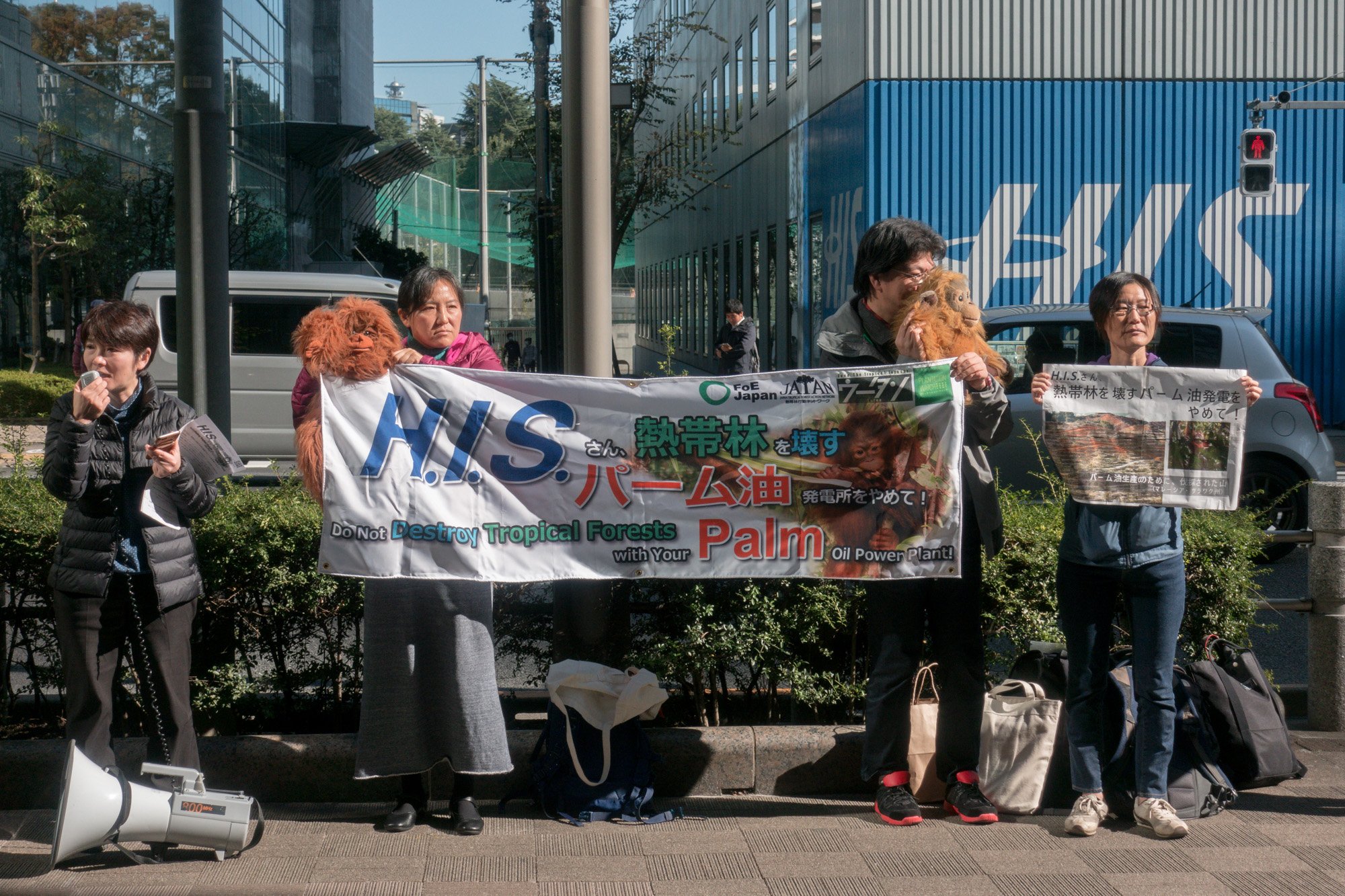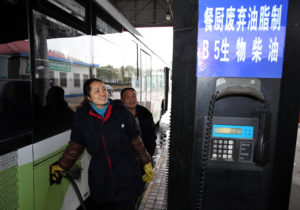In 2011, Japan faced an unprecedented energy crisis after the Tohoku earthquake had devastated the country and badly damaged the Fukushima Daiichi Nuclear Power Plant. The country’s entire nuclear fleet – 54 plants in total – was shut down for safety reasons. For months, the country faced power shortages and the risk of blackouts.
In response, the government attempted to bring more distributed renewable energy onto the grid by implementing a feed-in-tariff (FiT) in 2012. This made it compulsory for power companies to buy energy from renewable sources at a fixed price. While it increased the penetration of solar significantly, it also included a controversial energy source: palm oil.
The idea was to burn palm oil in power plants to generate electricity, and the policy incentivised operators by providing a fixed rate of 24 yen per kilowatt hour (US$0.18). At the time, this made it a highly profitable venture, as long as palm oil prices remained below 97 yen (US$0.80) per kilogram.
In the following years, dozens of projects were planned. Permitted plants totalled 1,700 megawatts (MW) by 2018 – enough to power up to 1.7 million homes for a year. If they all came to fruition, they would potentially require a quintupling of Japan’s annual imports of palm oil from Southeast Asia, from 720,000 tons to 3.4 million tons.
“There are concerns regarding the decline in biodiversity, greenhouse gas emissions and human rights issues in places where fuels such as palm oil are produced,” said Yuichiro Ishizaki, with the Osaka-based environmental non-profit Hutan.
Currently, only eight plants run by five companies have been built, capable of producing about 140 MW, though they have not been operating at full capacity due to high crude palm oil prices. Some larger planned projects have encountered local opposition, mainly due to concerns about noise and air pollution.
This opposition, coupled with the high palm oil price, and increasing sustainability requirements, could halt Japan’s plans to use palm oil in electricity generation, and dent hopes of increasing imports from the top two palm oil producers, Indonesia and Malaysia.
Biomass is organic matter that can be used to generate electricity.
In the palm oil industry, it usually takes the form of crude palm oil or of two by-products – palm kernel shells and empty fruit bunches.
Millions of tons of kernel shells and empty fruit bunches are produced every year. While these materials can be returned to plantations as a form of organic fertiliser, some palm oil mills have installed units to combust and generate power from them. Mills can also sell this material on to other companies for use in power generation.
In Japan, crude palm oil is considered a form of biomass energy and has been included in the government’s feed-in-tariff (FiT) scheme alongside palm kernel shells.
The biomass power plants discussed in this article all run on crude palm oil.
Local pushback
One of the biggest projects in the pipeline was a 66 MW plant in Maizuru, a city of 78,000 people in Kyoto prefecture on the north coast of Japan. It was to be operated by Maizuru Green Initiatives GK, and sponsored by Canadian company AMP Energy. But residents were aware of complaints about fumes and noise pollution at a recently constructed palm oil biomass plant in the nearby city of Fukuchiyama, and feared the same would happen in Maizuru.
One resident, Takashi Morimoto, led a campaign involving a website, petition, media engagement and information requests to the regional government. The campaigners even reached out to AMP Energy and one of the companies providing technology for the plant, Hitachi Zosen, to communicate their opposition.
In April 2020, Maizuru Green Initiatives announced its dissolution, a major setback to the planned project and a victory for local environmentalists and residents.
“The withdrawal from the palm oil power generation business in Maizuru city… was successful due to the passionate actions of local residents,” said Ishizaki. “Opposing residents put up red banner-flags in front of their houses. The unity of local residents and the movement’s visibility were a major force.”
Later that year, the Fukuchiyama plant also ceased operation, after residents filed complaints with the Kyoto Prefecture Pollution Review Board for compensation for damages due to air and noise pollution.
Now the focus is on the proposed plant in Ishinomaki, Miyagi prefecture, Tohoku, where an even larger project, run by a company called G-Bio Inc, is in the planning stage. This 103 MW plant will, according to environmental nonprofit Mighty Earth, consume hundreds of thousands of tons of palm oil a year. It, like the plant in Maizuru, is facing active local opposition.
“It’s located near the centre of a residential area. There is a risk that noise, stench and exhaust gas pollution will affect the entire district,” said Ishizaki. “As 33 fuel transportation trailers will pass through school routes with poor visibility every day, there are concerns regarding traffic accidents and health, and that land and house prices will drop due to reputational damage.”
Local campaigners have, following the model of the Maizuru movement, set up an online petition and are engaging Japanese media and G-Bio. Thus far, the company has resisted and is pushing forward with its plans.
Environmental and financial sustainability
The inclusion of palm oil in the FiT scheme is increasingly at odds with Japan’s own climate commitments. In 2020, the country announced it would reduce its greenhouse gas emissions by 25% from 2013 levels by 2030, and achieve carbon neutrality by 2050. The government is now requiring Japanese companies to disclose climate risks, and investing US$155 billion into a decarbonisation fund. There is also a push to make overseas investments more climate-friendly, including by ending financing of coal projects.
For Roger Smith, Japan director at Mighty Earth, continuing to allow electricity generated from palm oil biomass on the grid puts those goals at risk.
“Japan wants to use renewable energy to meet its climate targets and goals, but if they are using palm oil for electricity, they are actually making global emissions – and their own – worse,” said Smith.
It was already questionable to burn palm oil in 2012, but the science is now increasingly clear on its large climate impacts due to deforestation and land-use change linked to the crop’s cultivation in Southeast Asia, especially where plantations are established on carbon-rich peatlands. An analysis conducted by Friends of the Earth Japan found that, when you factor in land use change, generating electricity from palm oil grown on land cleared of tropical forest results in more greenhouse gas emissions per unit of electricity generated than the average fossil fuel-powered plant, and far more if the palm oil is grown on carbon-rich peatlands.
The efforts by environmental groups like Mighty Earth and Hutan have led to a significant policy change: to address sustainability concerns, from April of this year only palm oil certified by the Roundtable on Sustainable Palm Oil (RSPO) will be eligible under the FiT scheme. That, says Smith, is not enough.
“The RSPO was never designed for biomass electricity. It was designed for consumer products, so it has limitations for how useful it is,” said Smith. “Having standards is better than having no standards, but it does not address the heart of the problem.”
Subsidies that have gone to biomass could have supported more solar, more geothermal, offshore windRoger Smith, Japan director at Mighty Earth
It is unclear if this will even matter. The financial landscape for palm oil has changed significantly since 2012. Then, the price for crude palm oil was around US$500 per ton. Now, it’s around $900. During last year’s food oil price spike, it peaked at more than $1,500. At this price, palm oil biomass energy, even with subsidies, may not make financial sense. The RSPO requirement will also add to operational costs.
The result is that nearly all of the planned 1,700 MW are at a standstill. According to Sayoko Iinuma, of Japanese environmental non-profit Global Environmental Forum, there are concerns that project operators are trying to push Japan’s industrial ministry to include palm oil certified by Indonesia Sustainable Palm Oil (ISPO) and Malaysia Sustainable Palm Oil (MSPO) in the new FiT sustainability requirement. Those two schemes, backed by their respective national governments, are widely considered less stringent than the RSPO.
“If MSPO and ISPO are approved, it will be easier for operators to do business, and it is possible that previously certified FiT operators who have not been able to proceed with their projects will begin to do so,” said Iinuma.
Indonesia pushed Japan to accept ISPO certification at an economic meeting in September 2022. One reason may be the desire to find new markets due to requirements by the European Union limiting the use of palm oil in biofuels, alongside new due diligence import regulations on goods linked to deforestation.
Smith does not see much hope for the Ishinomaki project, or any of the others yet to be cancelled. He wishes that the government had focused on better sustainable energy options rather than allowing so much time and money to be spent on what he feels is a clearly climate-unfriendly solution.
“The subsidies that have gone to biomass could have supported more solar, more geothermal, offshore wind, all power sources that don’t require fuel and are actually coming down in price. While palm oil… is more expensive today than a decade ago,” said Smith.
For Ishizaki, it’s time for the government to realise its mistake, and remove palm oil from the FiT tariff, put an end to the Ishinomaki project, and stop subsidising the smaller facilities already operating.
“Biomass power generation is no longer recognised as carbon neutral,” said Ishizaki. “The FiT programme should be changed, and the operation of palm oil power generation should be reviewed in order to prevent deforestation, biodiversity loss and the further extinction of animals and plants.”













